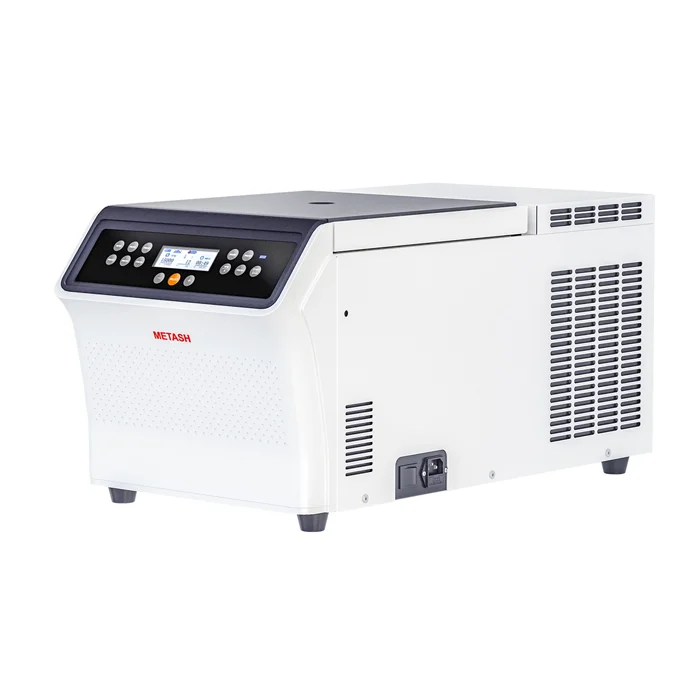- This topic is empty.
-
AuthorPosts
-
18/02/2025 at 17:56 #94630
Centrifuges help researchers and technicians separate substances of different densities using centrifugal force. Among them, a desktop high-speed centrifuge is a compact and efficient device used in a variety of applications, including molecular biology, clinical diagnostics, and drug research. In this blog post, as a high performance centrifuge machines for laboratory supplier, Metash will share the working principle of desktop high speed centrifuge for sale, its key components, and more.
A benchtop high-speed centrifuge is a small yet powerful device that operates at significantly high rotational speeds. Unlike standard laboratory centrifuges, which typically run at lower speeds, high-speed centrifuges can reach up to 30,000 revolutions per minute (RPM), generating extreme centrifugal forces that facilitate rapid separation of biological, chemical, and industrial samples.
This type of centrifuge is often used in research and medical laboratories where space is limited, yet high-performance separation is required. Whether in a hospital lab processing blood samples or a research facility analyzing DNA, benchtop high-speed centrifuges provide quick and efficient sample separation.
Key Components of Benchtop High Speed Centrifuge
To understand how a benchtop high-speed centrifuge works, it is important to familiarize ourselves with its key components:
1. Rotor: The rotor is the heart of the centrifuge, holding the sample tubes in place while spinning at high speeds. Rotors come in different designs, such as fixed-angle rotors and swinging-bucket rotors, each suited for specific applications.
2. Motor and Drive System: A powerful motor drives the rotation of the rotor. The drive system ensures smooth acceleration and deceleration while maintaining high-speed stability.
3. Control Panel: Modern benchtop centrifuges are equipped with digital control panels that allow users to set parameters such as speed (RPM), relative centrifugal force (RCF), temperature, and run time.
4. Refrigeration System: Some high-speed centrifuges include a cooling system to maintain a consistent temperature, crucial for temperature-sensitive samples like enzymes and proteins.
5. Safety Mechanisms: High-speed centrifuges operate under extreme forces, necessitating robust safety features. These include lid locks, imbalance detection, and emergency braking systems to prevent accidents.

Working Principle of Benchtop High Speed Centrifuge
1. Sample Preparation and Loading
Before starting the centrifuge, the user prepares the samples in appropriate centrifuge tubes. It is crucial to balance the samples properly to prevent excessive vibrations that could damage the equipment or affect separation efficiency.
2. Rotor Selection and Placement
The user selects the appropriate rotor based on the type of separation required. The rotor is then securely placed inside the centrifuge chamber.
3. Setting Parameters
Using the control panel, the user sets the desired speed (RPM), RCF, and run time. If the centrifuge is refrigerated, the temperature settings are adjusted to maintain sample integrity.
4. Acceleration and Centrifugation Process
Once the centrifuge starts, the motor rapidly accelerates the rotor to the preset speed. The centrifugal force generated pushes denser particles outward while lighter components remain closer to the center.
5. Deceleration and Sample Collection
After the set run time, the centrifuge decelerates smoothly to prevent sample disturbance. Once it stops, the lid unlocks, allowing safe retrieval of the separated samples.
Best Practices for Operating Benchtop High Speed Centrifuge
– Proper Sample Balancing: Always balance tubes by placing equal volumes on opposite sides of the rotor to prevent excessive vibrations.
– Routine Maintenance: Regularly clean the rotor, chamber, and exterior to prevent contamination and ensure smooth operation.
– Adhere to Speed Limits: Avoid exceeding the recommended speed limits for specific rotors to prevent damage.
– Monitor Temperature: If working with temperature-sensitive samples, ensure the refrigeration system is functioning properly.
– Follow Safety Guidelines: Always close the lid securely, and never open the centrifuge while it is running.
Conclusion
A benchtop high-speed centrifuge is an essential laboratory instrument that plays a crucial role in various scientific and medical applications. By understanding how it works, its key components, and best practices for operation, users can maximize its efficiency and ensure safe usage. Whether for DNA extraction, blood sample processing, or pharmaceutical research, these centrifuges offer reliable, high-speed separation in a compact design, making them invaluable tools in modern laboratories.
https://www.metashcorp.com/How-does-Desktop-High-Speed-Centrifuge-Work.html
http://www.metashcorp.com
Metash -
AuthorPosts
- You must be logged in to reply to this topic.
